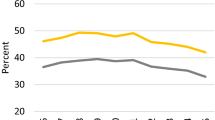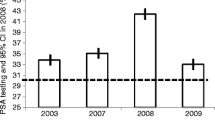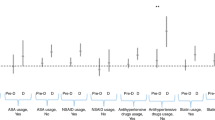Abstract
Purpose
Men with diabetes have been found to have a reduced risk of prostate cancer (PCa), potentially due to detection bias from lower prostate-specific antigen (PSA) levels or inhibition of tumor growth. Understanding if lower PCa rates are due to a lower risk of the disease or a detection bias from PSA testing can help inform the benefits and harms from prostate cancer screening.
Methods
We used data from the Prostate, Lung, Colorectal, and Ovarian (PLCO) Screening Trial to assess the impact of PSA screening on PCa in men with diabetes and the potential role of detection bias and/or slower tumor growth. Comparing men by diabetes status, we calculated age-adjusted incidence rates by tumor grade and compared screening results, PSA levels, and tumor characteristics.
Results
Men with diabetes had lower rates of PCa but was limited to low- and intermediate-grade tumors. Men with diabetes were less likely to be biopsied after their first positive screening test and men diagnosed with low/intermediate-grade tumors had significantly more advanced tumors with higher PSA levels.
Conclusions
Our findings provide additional evidence that detection bias is likely contributing to the lower rates of low- and intermediate-grade prostate cancers.

Similar content being viewed by others
Change history
30 November 2018
In the original publication of the article, the categories of PSA levels among the subpopulation of men diagnosed with prostate cancer were published incorrectly in Table 4. The corrected Table 4 is given in this Correction.
30 November 2018
In the original publication of the article, the categories of PSA levels among the subpopulation of men diagnosed with prostate cancer were published incorrectly in Table 4. The corrected Table 4 is given in this Correction.
References
Bonovas S, Filioussi K, Tsantes A (2004) Diabetes mellitus and risk of prostate cancer: a meta-analysis. Diabetologia 47(6):1071–1078
Kasper JS, Giovannucci E (2006) A meta-analysis of diabetes mellitus and the risk of prostate cancer. Cancer Epidemiol Biomarkers Prev 15(11):2056–2062
Bansal D, Bhansali A, Kapil G, Undela K, Tiwari P (2013) Type 2 diabetes and risk of prostate cancer: a meta-analysis of observational studies. Prostate Cancer Prostatic Dis 16(2):151–158
Fall K, Garmo H, Gudbjornsdottir S, Stattin P, Zethelius B (2013) Diabetes mellitus and prostate cancer risk; a nationwide case–control study within PCBaSe Sweden. Cancer Epidemiol Biomark Prev 22(6):1102–1109
Haggstrom C, Van Hemelrijck M, Zethelius B, Robinson D, Grundmark B, Holmberg L et al (2016) Prospective study of type 2 diabetes mellitus, anti-diabetic drugs and risk of prostate cancer. Int J Cancer 140:611–617
Harding JL, Shaw JE, Peeters A, Cartensen B, Magliano DJ (2015) Cancer risk among people with type 1 and type 2 diabetes: disentangling true associations, detection bias, and reverse causation. Diabetes Care 38(4):264–270
Liu X, Hemminki K, Forsti A, Sundquist K, Sundquist J, Ji J (2015) Cancer risk in patients with type 2 diabetes mellitus and their relatives. Int J Cancer 137(4):903–910
Tsilidis KK, Allen NE, Appleby PN, Rohrmann S, Nothlings U, Arriola L et al (2015) Diabetes mellitus and risk of prostate cancer in the European prospective investigation into cancer and nutrition. Int J Cancer 136(2):372–381
Zhu K, Lee IM, Sesso HD, Buring JE, Levine RS, Gaziano JM (2004) History of diabetes mellitus and risk of prostate cancer in physicians. Am J Epidemiol 159(10):978–982
Dankner R, Boffetta P, Keinan-Boker L, Balicer RD, Berlin A, Olmer L et al (2016) Diabetes, prostate cancer screening and risk of low- and high-grade prostate cancer: an 11 year historical population follow-up study of more than 1 million men. Diabetologia 59(8):1683–1691
Kasper JS, Liu Y, Giovannucci E (2009) Diabetes mellitus and risk of prostate cancer in the health professionals follow-up study. Int J Cancer 124(6):1398–1403
Leitzmann MF, Ahn J, Albanes D, Hsing AW, Schatzkin A, Chang SC et al (2008) Diabetes mellitus and prostate cancer risk in the prostate, lung, colorectal, and ovarian cancer screening trial. Cancer Causes Control 19(10):1267–1276
Xu H, Jiang HW, Ding GX, Zhang H, Zhang LM, Mao SH et al (2013) Diabetes mellitus and prostate cancer risk of different grade or stage: a systematic review and meta-analysis. Diabetes Res Clin Pract 99(3):241–249
Giovannucci E, Rimm EB, Stampfer MJ, Colditz GA, Willett WC (1998) Diabetes mellitus and risk of prostate cancer (United States). Cancer Causes Control 9(1):3–9
Peskoe SB, Joshu CE, Rohrmann S, McGlynn KA, Nyante SJ, Bradwin G et al (2015) Circulating total testosterone and PSA concentrations in a nationally representative sample of men without a diagnosis of prostate cancer. Prostate 75(11):1167–1176
Barrett-Connor E (1992) Lower endogenous androgen levels and dyslipidemia in men with non-insulin-dependent diabetes mellitus. Ann Intern Med 117(10):807–811
Betancourt-Albrecht M, Cunningham GR (2003) Hypogonadism and diabetes. Int J Impot Res 15(Suppl 4):S14–S20
Pierce BL (2012) Why are diabetics at reduced risk for prostate cancer? A review of the epidemiologic evidence. Urol Oncol 30(5):735–743
US Preventive Services Task Force (2017) U.S. Preventive Services Task Force seeks comments on draft recommendation statement on screening for Prostate Cancer. https://www.uspreventiveservicestaskforce.org/Home/GetFile/6/250/prostate-cancer-draft-bulletin/pdf
Grubb RL 3rd, Pinsky PF, Greenlee RT, Izmirlian G, Miller AB, Hickey TP et al (2008) Prostate cancer screening in the prostate, lung, colorectal and ovarian cancer screening trial: update on findings from the initial four rounds of screening in a randomized trial. BJU Int 102(11):1524–1530
Prorok PC, Andriole GL, Bresalier RS, Buys SS, Chia D, Crawford ED et al (2000) Design of the prostate, lung, colorectal and ovarian (PLCO) cancer screening trial. Control Clin Trials 21(6 Suppl):273S–309S
Rusthoven CG, Carlson JA, Waxweiler TV, Yeh, Raben D, Flaig TW et al (2014) The prognostic significance of Gleason scores in metastatic prostate cancer. Urol Oncol 32(5):707–713
Author information
Authors and Affiliations
Corresponding author
Rights and permissions
About this article
Cite this article
Miller, E.A., Pinsky, P.F. & Pierre-Victor, D. The relationship between diabetes, prostate-specific antigen screening tests, and prostate cancer. Cancer Causes Control 29, 907–914 (2018). https://doi.org/10.1007/s10552-018-1067-3
Received:
Accepted:
Published:
Issue Date:
DOI: https://doi.org/10.1007/s10552-018-1067-3




